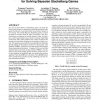179 search results - page 15 / 36 » Adversarial Leakage in Games |
EUROCRYPT
2006
Springer
14 years 1 months ago
2006
Springer
We show that, in the ideal-cipher model, triple encryption (the cascade of three independently-keyed blockciphers) is more secure than single or double encryption, thereby resolvin...
IFIP
2009
Springer
14 years 4 months ago
2009
Springer
Security API analysis typically only considers a subset of an API’s functions, with results bounded by the number of function calls. Furthermore, attacks involving partial leakag...
ATAL
2008
Springer
13 years 11 months ago
2008
Springer
In a class of games known as Stackelberg games, one agent (the leader) must commit to a strategy that can be observed by the other agent (the follower or adversary) before the adv...
HRI
2009
ACM
14 years 2 months ago
2009
ACM
Human communication involves a number of nonverbal cues that are seemingly unintentional, unconscious, and automatic—both in their production and perception—and convey rich in...
CHES
2000
Springer
14 years 2 months ago
2000
Springer
This paper will attempt to explain some of the side-channel attack techniques in a fashion that is easily comprehensible by the layman. What follows is a presentation of three di�...




